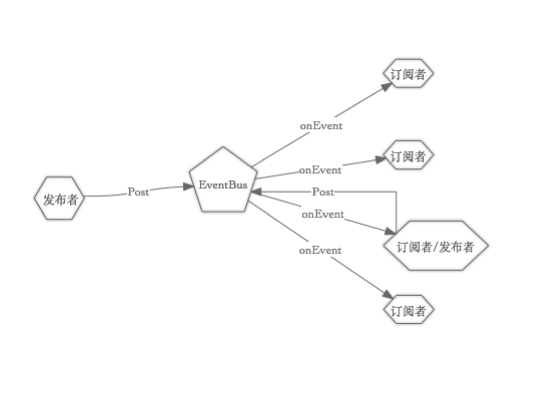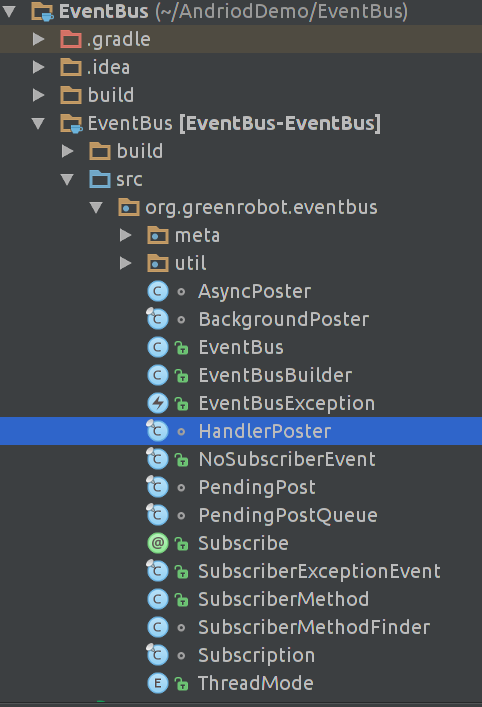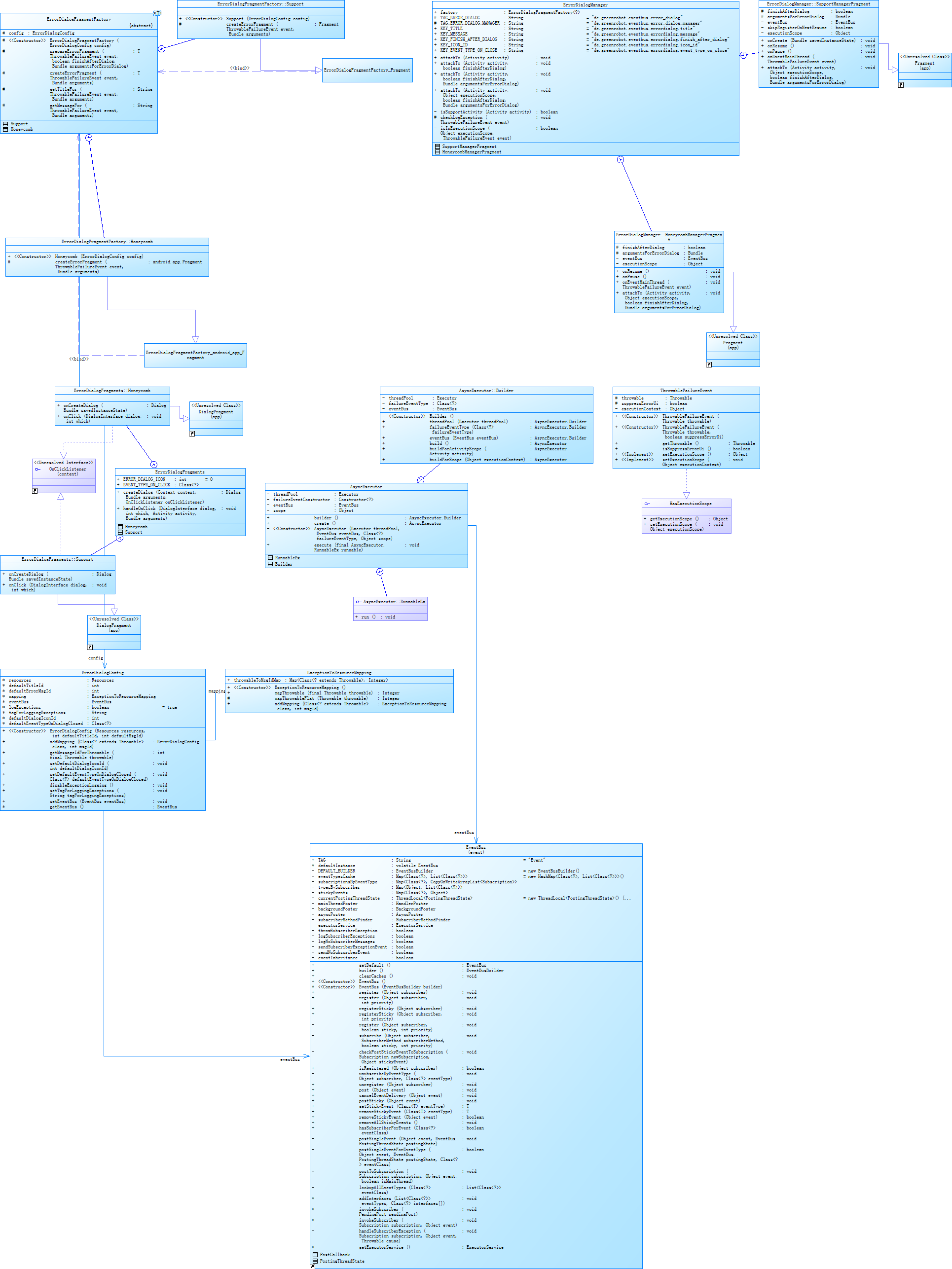EventBus源码分析
2016-10-18 18:18
183 查看
在进入EventBus源码分析之前,如果对EventBus的使用还不是很清楚的,可以参考上一篇文章EventBus使用
首先我们先通过一张简单的图来了解一下EventBus的工作原理:
EventBus工作原理图:

也可以看这张图:

当然作为一名Android开发人员,我们肯定是想更深入地了解EventBus是怎么工作的,所以探讨源码是必不可少的。所以我们将进行EventBus源码的解读,并了解其架构的实现和工作原理,并通过源码解读,更加深入的了解各种使用场景和事件类型,响应Mode。
EventBus 源码地址:https://github.com/greenrobot/EventBus.git
下载源码后,我们将其导入到Android Studio中,代码目录比较简单,如下图展示:

为了更好的了解和认识EventBus的代码结构和类关系,把代码导入到了PD中,生成了类关系图,如下图所示:

从上图可以看出,主要使用到的是EventBus.java主类,此类主要提供了一些接口的封装和逻辑处理,默认EventBus实例的创建和应用。下面我们来进入代码,根据源码看看EventBus是怎么走的。
EventBus的实例化:
默认调用的EventBus是单例存在,如果想自定义创建更多的EventBus,可以通过EventBusBuilder进行创建,在
中做了如下几件事,其实已经在代码中注释了:
1、创建订阅事件类型HashMap,用于存储注册类中订阅的事件对应的所有方法,key为class即订阅类,value为CopyOnWriteArrayList,此列表记录了相同事件类型的所有订阅方法列表。
其中CopyOnWriteArrayList是ArrayList的一种衍生类型,此类适用于多线程同时需要对list进行操作和遍历的场景,在add对象时会对原本list进行copy后再进行操作更新,防止出现java.util.ConcurrentModificationException错误。 Subscription是订阅者对象:
订阅者对象中记录了对订阅者回调事件函数和订阅优先级的记录,用于订阅事件函数插入的排序。
2、 创建typesBySubscriber,用于记录subscriber中已经注册的eventType类型情况
3、 创建stickyEvents,用于记录和检查发送sticky事件
4、接下来是创建3中不同Mode的Poster:
5、 SubscriberMethodFinder的创建,用于遍历查找注册者类中的特殊名字方法,即订阅事件的回调函数。
6、EventBus的常用参数配置,包括异常信息,log信息等
接下来我们来看看EventBus的注册过程
EventBus的注册流程:
从上述代码我们可以验证上一篇EventBus的使用中说的,注册只需要一行代码搞定:
也就是默认把当前类注册到EventBus队列中,具体实现逻辑在这里可以看到:
当一个类需要往EventBus中注册自己时,通过Finder遍历类中以onEvent开头命名的函数,并把函数中第一个参数当做eventType,并过滤掉一些特殊的方法,把最后结果输出到subscriberMethods中,接着一个接一个得创建订阅,并add到上面描述的list中,为以后的事件发布做准备。也就是通过一个findSubscriberMethods方法找到了一个订阅者中的所有订阅方法,返回一个 List,进入到findSubscriberMethods看看如何实现的。
我已经在源码上注释了,大家可以看看。
SubscriberMethodFinder中的findSubscriberMethods是主要实现遍历传入类中以onEvent开头函数列表的。从代码中我们可以看出它遍历时不需要关心的一些描述和包:
EventBus的反注册流程:
反注册流程,其实就是从订阅列表中移除订阅者的操作。
EventBus的post流程,事件发布流程:
在完成事件订阅后,基本上订阅操作就可以告一段落了,接下来就等着事件的发布,事件的发布主要是通过以下逻辑实现:
这里主要是事件的发布,而事件的分发跟核心处理在postSingleEvent(Object event, PostingThreadState postingState)这个方法里面。
这里做了一件事情,在前段描述的事件列表中,根据ecentType进行查找遍历是否有此事件类型的订阅者,如果有则post出去,如果没有,则post一个NoSubscriberEvent事件。
当找到订阅事件时,我们需要遍历找出对应事件订阅的订阅者,再进行反射调用其处理函数进行通知处理。
现在讲解事件的几个Mode:
在EventBus中的观察者通常有四种订阅函数(就是某件事情发生被调用的方法)
1、onEvent
2、onEventMainThread
3、onEventBackground
4、onEventAsync
这四种订阅函数都是使用onEvent开头的,它们的功能稍有不同,在介绍不同之前先介绍两个概念:
告知观察者事件发生时通过EventBus.post函数实现,这个过程叫做事件的发布,观察者被告知事件发生叫做事件的接收,是通过下面的订阅函数实现的。
onEvent:如果使用onEvent作为订阅函数,那么该事件在哪个线程发布出来的,onEvent就会在这个线程中运行,也就是说发布事件和接收事件线程在同一个线程。使用这个方法时,在onEvent方法中不能执行耗时操作,如果执行耗时操作容易导致事件分发延迟。
onEventMainThread:如果使用onEventMainThread作为订阅函数,那么不论事件是在哪个线程中发布出来的,onEventMainThread都会在UI线程中执行,接收事件就会在UI线程中运行,这个在Android中是非常有用的,因为在Android中只能在UI线程中跟新UI,所以在onEvnetMainThread方法中是不能执行耗时操作的。
onEvnetBackground:如果使用onEventBackgrond作为订阅函数,那么如果事件是在UI线程中发布出来的,那么onEventBackground就会在子线程中运行,如果事件本来就是子线程中发布出来的,那么onEventBackground函数直接在该子线程中执行。
onEventAsync:使用这个函数作为订阅函数,那么无论事件在哪个线程发布,都会创建新的子线程在执行onEventAsync.
PostThread:默认模式,在 Post 操作的线程直接调用订阅者的事件响应方法,不论该线程什么线程。当该线程为主线程时,响应方法中不要有耗时操作,否则会发生anr。
MainThread:在主线程中执行响应,如果发布线程就是主线程,则直接调用订阅者的事件响应方法,否则通过主线程的 Handler post回主线程中调用订阅者的事件响应方法。
BackgroundThread:在后台线程中执行响应方法。如果发布线程非主线程,则直接调用订阅者的事件响应函数,否则启动EventBus中唯一的后台线程去处理。由于后台线程是唯一的,当事件超过一个的时候,它们会被放在队列中依次执行,请不要把耗时操作放此进行,否则会阻塞后台队列的依次执行。
Async:使用一个空闲线程来处理。和上面不同的是,这里的所有线程是相互独立的,不会出现卡线程的问题。
至于这里调用订阅者的事件响应方法都是利用了反射原理,主要的创建,注册,订阅,发布和发注册流程就是以上的源码部分
首先我们先通过一张简单的图来了解一下EventBus的工作原理:
EventBus工作原理图:

也可以看这张图:

当然作为一名Android开发人员,我们肯定是想更深入地了解EventBus是怎么工作的,所以探讨源码是必不可少的。所以我们将进行EventBus源码的解读,并了解其架构的实现和工作原理,并通过源码解读,更加深入的了解各种使用场景和事件类型,响应Mode。
EventBus 源码地址:https://github.com/greenrobot/EventBus.git
下载源码后,我们将其导入到Android Studio中,代码目录比较简单,如下图展示:

为了更好的了解和认识EventBus的代码结构和类关系,把代码导入到了PD中,生成了类关系图,如下图所示:

从上图可以看出,主要使用到的是EventBus.java主类,此类主要提供了一些接口的封装和逻辑处理,默认EventBus实例的创建和应用。下面我们来进入代码,根据源码看看EventBus是怎么走的。
EventBus的实例化:
/** Convenience singleton for apps using a process-wide EventBus instance. */
public static EventBus getDefault() {
if (defaultInstance == null) {
synchronized (EventBus.class) {
if (defaultInstance == null) {
defaultInstance = new EventBus();
}
}
}
return defaultInstance;
}
public static EventBusBuilder builder() {
return new EventBusBuilder();
}
/** For unit test primarily. */
public static void clearCaches() {
SubscriberMethodFinder.clearCaches();
eventTypesCache.clear();
}
/**
* Creates a new EventBus instance; each instance is a separate scope in which events are delivered. To use a
* central bus, consider {@link #getDefault()}.
*/
public EventBus() {
this(DEFAULT_BUILDER);
}
EventBus(EventBusBuilder builder) {
// 创建订阅事件类型HashMap,用于存储注册类中订阅的事件对应的所有方法,key为class即订阅类,value为CopyOnWriteArrayList<Subscription>,此列表记录了相同事件类型的所有订阅方法列表。
subscriptionsByEventType = new HashMap<>();
//创建typesBySubscriber,用于记录subscriber中已经注册的eventType类型情况
typesBySubscriber = new HashMap<>();
//创建stickyEvents,用于记录和检查发送sticky事件
stickyEvents = new ConcurrentHashMap<>();
//接下来是创建3中不同Mode的Poster
mainThreadPoster = new HandlerPoster(this, Looper.getMainLooper(), 10);
backgroundPoster = new BackgroundPoster(this);
asyncPoster = new AsyncPoster(this);
indexCount = builder.subscriberInfoIndexes != null ? builder.subscriberInfoIndexes.size() : 0;
//SubscriberMethodFinder的创建,用于遍历查找注册者类中的特殊名字方法,即订阅事件的回调函数。
subscriberMethodFinder = new SubscriberMethodFinder(builder.subscriberInfoIndexes,
builder.strictMethodVerification, builder.ignoreGeneratedIndex);
//EventBus的常用参数配置,包括异常信息,log信息等
logSubscriberExceptions = builder.logSubscriberExceptions;
logNoSubscriberMessages = builder.logNoSubscriberMessages;
sendSubscriberExceptionEvent = builder.sendSubscriberExceptionEvent;
sendNoSubscriberEvent = builder.sendNoSubscriberEvent;
throwSubscriberException = builder.throwSubscriberException;
eventInheritance = builder.eventInheritance;
executorService = builder.executorService;
}默认调用的EventBus是单例存在,如果想自定义创建更多的EventBus,可以通过EventBusBuilder进行创建,在
EventBus(EventBusBuilder builder)
中做了如下几件事,其实已经在代码中注释了:
1、创建订阅事件类型HashMap,用于存储注册类中订阅的事件对应的所有方法,key为class即订阅类,value为CopyOnWriteArrayList,此列表记录了相同事件类型的所有订阅方法列表。
其中CopyOnWriteArrayList是ArrayList的一种衍生类型,此类适用于多线程同时需要对list进行操作和遍历的场景,在add对象时会对原本list进行copy后再进行操作更新,防止出现java.util.ConcurrentModificationException错误。 Subscription是订阅者对象:
final class Subscription {
final Object subscriber;
final SubscriberMethod subscriberMethod;
/**
* Becomes false as soon as {@link EventBus#unregister(Object)} is called, which is checked by queued event delivery
* {@link EventBus#invokeSubscriber(PendingPost)} to prevent race conditions.
*/
volatile boolean active;
Subscription(Object subscriber, SubscriberMethod subscriberMethod) {
this.subscriber = subscriber;
this.subscriberMethod = subscriberMethod;
active = true;
}
@Override
public boolean equals(Object other) {
if (other instanceof Subscription) {
Subscription otherSubscription = (Subscription) other;
return subscriber == otherSubscription.subscriber
&& subscriberMethod.equals(otherSubscription.subscriberMethod);
} else {
return false;
}
}
@Override
public int hashCode() {
return subscriber.hashCode() + subscriberMethod.methodString.hashCode();
}
}订阅者对象中记录了对订阅者回调事件函数和订阅优先级的记录,用于订阅事件函数插入的排序。
2、 创建typesBySubscriber,用于记录subscriber中已经注册的eventType类型情况
3、 创建stickyEvents,用于记录和检查发送sticky事件
4、接下来是创建3中不同Mode的Poster:
mainThreadPoster = new HandlerPoster(this, Looper.getMainLooper(), 10); backgroundPoster = new BackgroundPoster(this); asyncPoster = new AsyncPoster(this);
5、 SubscriberMethodFinder的创建,用于遍历查找注册者类中的特殊名字方法,即订阅事件的回调函数。
6、EventBus的常用参数配置,包括异常信息,log信息等
接下来我们来看看EventBus的注册过程
EventBus的注册流程:
/**
* Registers the
123b5
given subscriber to receive events. Subscribers must call {@link #unregister(Object)} once they
* are no longer interested in receiving events.
* <p/>
* Subscribers have event handling methods that must be annotated by {@link Subscribe}.
* The {@link Subscribe} annotation also allows configuration like {@link
* ThreadMode} and priority.
*/
public void register(Object subscriber) {
Class<?> subscriberClass = subscriber.getClass();
//通过一个findSubscriberMethods方法找到了一个订阅者中的所有订阅方法,返回一个 List<SubscriberMethod>
List<SubscriberMethod> subscriberMethods = subscriberMethodFinder.findSubscriberMethods(subscriberClass);
synchronized (this) {
for (SubscriberMethod subscriberMethod : subscriberMethods) {
subscribe(subscriber, subscriberMethod);
}
}
}
// Must be called in synchronized block
private void subscribe(Object subscriber, SubscriberMethod subscriberMethod) {
//从订阅方法中拿到订阅事件的类型
Class<?> eventType = subscriberMethod.eventType;
//创建一个新的订阅
Subscription newSubscription = new Subscription(subscriber, subscriberMethod);
//通过订阅事件类型,找到所有的订阅(Subscription),订阅中包含了订阅者,订阅方法
CopyOnWriteArrayList<Subscription> subscriptions = subscriptionsByEventType.get(eventType);
//将新建的订阅加入到这个事件类型对应的所有订阅列表
if (subscriptions == null) {
//如果该事件目前没有订阅列表,那么创建并加入该订阅
subscriptions = new CopyOnWriteArrayList<>();
subscriptionsByEventType.put(eventType, subscriptions);
} else {
//如果有订阅列表,检查是否已经加入过
if (subscriptions.contains(newSubscription)) {
throw new EventBusException("Subscriber " + subscriber.getClass() + " already registered to event "
+ eventType);
}
}
//根据优先级插入订阅
int size = subscriptions.size();
for (int i = 0; i <= size; i++) {
if (i == size || subscriberMethod.priority > subscriptions.get(i).subscriberMethod.priority) {
subscriptions.add(i, newSubscription);
break;
}
}
//将这个订阅事件加入到订阅者的订阅事件列表中
List<Class<?>> subscribedEvents = typesBySubscriber.get(subscriber);
if (subscribedEvents == null) {
subscribedEvents = new ArrayList<>();
typesBySubscriber.put(subscriber, subscribedEvents);
}
subscribedEvents.add(eventType);
if (subscriberMethod.sticky) {
if (eventInheritance) {
// Existing sticky events of all subclasses of eventType have to be considered.
// Note: Iterating over all events may be inefficient with lots of sticky events,
// thus data structure should be changed to allow a more efficient lookup
// (e.g. an additional map storing sub classes of super classes: Class -> List<Class>).
Set<Map.Entry<Class<?>, Object>> entries = stickyEvents.entrySet();
for (Map.Entry<Class<?>, Object> entry : entries) {
Class<?> candidateEventType = entry.getKey();
if (eventType.isAssignableFrom(candidateEventType)) {
Object stickyEvent = entry.getValue();
checkPostStickyEventToSubscription(newSubscription, stickyEvent);
}
}
} else {
Object stickyEvent = stickyEvents.get(eventType);
checkPostStickyEventToSubscription(newSubscription, stickyEvent);
}
}
}
private void checkPostStickyEventToSubscription(Subscription newSubscription, Object stickyEvent) {
if (stickyEvent != null) {
// If the subscriber is trying to abort the event, it will fail (event is not tracked in posting state)
// --> Strange corner case, which we don't take care of here.
postToSubscription(newSubscription, stickyEvent, Looper.getMainLooper() == Looper.myLooper());
}
}从上述代码我们可以验证上一篇EventBus的使用中说的,注册只需要一行代码搞定:
EventBus.getDefault().register(this);
也就是默认把当前类注册到EventBus队列中,具体实现逻辑在这里可以看到:
List<SubscriberMethod> subscriberMethods = subscriberMethodFinder.findSubscriberMethods(subscriberClass);
synchronized (this) {
for (SubscriberMethod subscriberMethod : subscriberMethods) {
subscribe(subscriber, subscriberMethod);
}
}当一个类需要往EventBus中注册自己时,通过Finder遍历类中以onEvent开头命名的函数,并把函数中第一个参数当做eventType,并过滤掉一些特殊的方法,把最后结果输出到subscriberMethods中,接着一个接一个得创建订阅,并add到上面描述的list中,为以后的事件发布做准备。也就是通过一个findSubscriberMethods方法找到了一个订阅者中的所有订阅方法,返回一个 List,进入到findSubscriberMethods看看如何实现的。
List<SubscriberMethod> findSubscriberMethods(Class<?> subscriberClass) {
List<SubscriberMethod> subscriberMethods = METHOD_CACHE.get(subscriberClass);
if (subscriberMethods != null) {
return subscriberMethods;
}
if (ignoreGeneratedIndex) {
subscriberMethods = findUsingReflection(subscriberClass);
} else {
subscriberMethods = findUsingInfo(subscriberClass);
}
if (subscriberMethods.isEmpty()) {
throw new EventBusException("Subscriber " + subscriberClass
+ " and its super classes have no public methods with the @Subscribe annotation");
} else {
METHOD_CACHE.put(subscriberClass, subscriberMethods);
return subscriberMethods;
}
}
private List<SubscriberMethod> findUsingInfo(Class<?> subscriberClass) {
FindState findState = prepareFindState();
findState.initForSubscriber(subscriberClass);
while (findState.clazz != null) {
findState.subscriberInfo = getSubscriberInfo(findState);
if (findState.subscriberInfo != null) {
SubscriberMethod[] array = findState.subscriberInfo.getSubscriberMethods();
for (SubscriberMethod subscriberMethod : array) {
if (findState.checkAdd(subscriberMethod.method, subscriberMethod.eventType)) {
findState.subscriberMethods.add(subscriberMethod);
}
}
} else {
findUsingReflectionInSingleClass(findState);
}
findState.moveToSuperclass();
}
return getMethodsAndRelease(findState);
}
private List<SubscriberMethod> findUsingReflection(Class<?> subscriberClass) {
FindState findState = prepareFindState();
findState.initForSubscriber(subscriberClass);
while (findState.clazz != null) {
findUsingReflectionInSingleClass(findState);
findState.moveToSuperclass();
}
return getMethodsAndRelease(findState);
}
private void findUsingReflectionInSingleClass(FindState findState) {
Method[] methods;
try {
// This is faster than getMethods, especially when subscribers are fat classes like Activities
methods = findState.clazz.getDeclaredMethods();
} catch (Throwable th) {
// Workaround for java.lang.NoClassDefFoundError, see https://github.com/greenrobot/EventBus/issues/149 methods = findState.clazz.getMethods();
findState.skipSuperClasses = true;
}
for (Method method : methods) {
int modifiers = method.getModifiers();
//判断订阅者是否是public的,并且是否有修饰符,看来订阅者只能是public的,并且不能被final,static等修饰
if ((modifiers & Modifier.PUBLIC) != 0 && (modifiers & MODIFIERS_IGNORE) == 0) {
//获得订阅函数的参数
Class<?>[] parameterTypes = method.getParameterTypes();
//看了参数的个数只能是1个
if (parameterTypes.length == 1) {
Subscribe subscribeAnnotation = method.getAnnotation(Subscribe.class);
if (subscribeAnnotation != null) {
Class<?> eventType = parameterTypes[0];
if (findState.checkAdd(method, eventType)) {
ThreadMode threadMode = subscribeAnnotation.threadMode();
findState.subscriberMethods.add(new SubscriberMethod(method, eventType, threadMode,
subscribeAnnotation.priority(), subscribeAnnotation.sticky()));
}
}
} else if (strictMethodVerification && method.isAnnotationPresent(Subscribe.class)) {
//通过反射,获取到订阅者的所有方法
String methodName = method.getDeclaringClass().getName() + "." + method.getName();
throw new EventBusException("@Subscribe method " + methodName +
"must have exactly 1 parameter but has " + parameterTypes.length);
}
} else if (strictMethodVerification && method.isAnnotationPresent(Subscribe.class)) {
String methodName = method.getDeclaringClass().getName() + "." + method.getName();
throw new EventBusException(methodName +
" is a illegal @Subscribe method: must be public, non-static, and non-abstract");
}
}
}我已经在源码上注释了,大家可以看看。
SubscriberMethodFinder中的findSubscriberMethods是主要实现遍历传入类中以onEvent开头函数列表的。从代码中我们可以看出它遍历时不需要关心的一些描述和包:
/* * In newer class files, compilers may add methods. Those are called bridge or synthetic methods. * EventBus must ignore both. There modifiers are not public but defined in the Java class file format: * http://docs.oracle.com/javase/specs/jvms/se7/html/jvms-4.html#jvms-4.6-200-A.1 */ private static final int BRIDGE = 0x40; private static final int SYNTHETIC = 0x1000; private static final int MODIFIERS_IGNORE = Modifier.ABSTRACT | Modifier.STATIC | BRIDGE | SYNTHETIC;
if (name.startsWith("java.") || name.startsWith("javax.") || name.startsWith("android.")) {
// Skip system classes, this just degrades performance
break;
}EventBus的反注册流程:
/** Unregisters the given subscriber from all event classes. */
public synchronized void unregister(Object subscriber) {
List<Class<?>> subscribedTypes = typesBySubscriber.get(subscriber);
if (subscribedTypes != null) {
for (Class<?> eventType : subscribedTypes) {
unsubscribeByEventType(subscriber, eventType);
}
typesBySubscriber.remove(subscriber);
} else {
Log.w(TAG, "Subscriber to unregister was not registered before: " + subscriber.getClass());
}
}反注册流程,其实就是从订阅列表中移除订阅者的操作。
EventBus的post流程,事件发布流程:
在完成事件订阅后,基本上订阅操作就可以告一段落了,接下来就等着事件的发布,事件的发布主要是通过以下逻辑实现:
/** Posts the given event to the event bus. */
public void post(Object event) {
//这个EventBus中只有一个,差不多是个单例吧
PostingThreadState postingState = currentPostingThreadState.get();
List<Object> eventQueue = postingState.eventQueue;
//将事件放入队列
eventQueue.add(event);
if (!postingState.isPosting) {
postingState.isMainThread = Looper.getMainLooper() == Looper.myLooper();
postingState.isPosting = true;
if (postingState.canceled) {
throw new EventBusException("Internal error. Abort state was not reset");
}
try {
while (!eventQueue.isEmpty()) {
//分发事件
postSingleEvent(eventQueue.remove(0), postingState);
}
} finally {
postingState.isPosting = false;
postingState.isMainThread = false;
}
}
}这里主要是事件的发布,而事件的分发跟核心处理在postSingleEvent(Object event, PostingThreadState postingState)这个方法里面。
private void postSingleEvent(Object event, PostingThreadState postingState) throws Error {
Class<?> eventClass = event.getClass();
boolean subscriptionFound = false;
if (eventInheritance) {
//找到eventClass对应的事件,包含父类对应的事件和接口对应的事件
List<Class<?>> eventTypes = lookupAllEventTypes(eventClass);
int countTypes = eventTypes.size();
for (int h = 0; h < countTypes; h++) {
Class<?> clazz = eventTypes.get(h);
subscriptionFound |= postSingleEventForEventType(event, postingState, clazz);
}
} else {
subscriptionFound = postSingleEventForEventType(event, postingState, eventClass);
}
if (!subscriptionFound) {
if (logNoSubscriberMessages) {
Log.d(TAG, "No subscribers registered for event " + eventClass);
}
if (sendNoSubscriberEvent && eventClass != NoSubscriberEvent.class &&
eventClass != SubscriberExceptionEvent.class) {
//如果没有订阅发现,那么会Post一个NoSubscriberEvent事件
post(new NoSubscriberEvent(this, event));
}
}
}这里做了一件事情,在前段描述的事件列表中,根据ecentType进行查找遍历是否有此事件类型的订阅者,如果有则post出去,如果没有,则post一个NoSubscriberEvent事件。
private boolean postSingleEventForEventType(Object event, PostingThreadState postingState, Class<?> eventClass) {
CopyOnWriteArrayList<Subscription> subscriptions;
synchronized (this) {
//找到订阅事件对应的订阅,这个是通过register加入的
subscriptions = subscriptionsByEventType.get(eventClass);
}
if (subscriptions != null && !subscriptions.isEmpty()) {
for (Subscription subscription : subscriptions) {
postingState.event = event;
postingState.subscription = subscription;
boolean aborted = false;
try {
//对每个订阅调用该方法
postToSubscription(subscription, event, postingState.isMainThread);
aborted = postingState.canceled;
} finally {
postingState.event = null;
postingState.subscription = null;
postingState.canceled = false;
}
if (aborted) {
break;
}
}
return true;
}
return false;
}当找到订阅事件时,我们需要遍历找出对应事件订阅的订阅者,再进行反射调用其处理函数进行通知处理。
private void postToSubscription(Subscription subscription, Object event, boolean isMainThread) {
switch (subscription.subscriberMethod.threadMode) {
case PostThread:
invokeSubscriber(subscription, event);
break;
case MainThread:
if (isMainThread) {
invokeSubscriber(subscription, event);
} else {
mainThreadPoster.enqueue(subscription, event);
}
break;
case BackgroundThread:
if (isMainThread) {
backgroundPoster.enqueue(subscription, event);
} else {
invokeSubscriber(subscription, event);
}
break;
case Async:
asyncPoster.enqueue(subscription, event);
break;
default:
throw new IllegalStateException("Unknown thread mode: " + subscription.subscriberMethod.threadMode);
}
}现在讲解事件的几个Mode:
在EventBus中的观察者通常有四种订阅函数(就是某件事情发生被调用的方法)
1、onEvent
2、onEventMainThread
3、onEventBackground
4、onEventAsync
这四种订阅函数都是使用onEvent开头的,它们的功能稍有不同,在介绍不同之前先介绍两个概念:
告知观察者事件发生时通过EventBus.post函数实现,这个过程叫做事件的发布,观察者被告知事件发生叫做事件的接收,是通过下面的订阅函数实现的。
onEvent:如果使用onEvent作为订阅函数,那么该事件在哪个线程发布出来的,onEvent就会在这个线程中运行,也就是说发布事件和接收事件线程在同一个线程。使用这个方法时,在onEvent方法中不能执行耗时操作,如果执行耗时操作容易导致事件分发延迟。
onEventMainThread:如果使用onEventMainThread作为订阅函数,那么不论事件是在哪个线程中发布出来的,onEventMainThread都会在UI线程中执行,接收事件就会在UI线程中运行,这个在Android中是非常有用的,因为在Android中只能在UI线程中跟新UI,所以在onEvnetMainThread方法中是不能执行耗时操作的。
onEvnetBackground:如果使用onEventBackgrond作为订阅函数,那么如果事件是在UI线程中发布出来的,那么onEventBackground就会在子线程中运行,如果事件本来就是子线程中发布出来的,那么onEventBackground函数直接在该子线程中执行。
onEventAsync:使用这个函数作为订阅函数,那么无论事件在哪个线程发布,都会创建新的子线程在执行onEventAsync.
PostThread:默认模式,在 Post 操作的线程直接调用订阅者的事件响应方法,不论该线程什么线程。当该线程为主线程时,响应方法中不要有耗时操作,否则会发生anr。
MainThread:在主线程中执行响应,如果发布线程就是主线程,则直接调用订阅者的事件响应方法,否则通过主线程的 Handler post回主线程中调用订阅者的事件响应方法。
BackgroundThread:在后台线程中执行响应方法。如果发布线程非主线程,则直接调用订阅者的事件响应函数,否则启动EventBus中唯一的后台线程去处理。由于后台线程是唯一的,当事件超过一个的时候,它们会被放在队列中依次执行,请不要把耗时操作放此进行,否则会阻塞后台队列的依次执行。
Async:使用一个空闲线程来处理。和上面不同的是,这里的所有线程是相互独立的,不会出现卡线程的问题。
至于这里调用订阅者的事件响应方法都是利用了反射原理,主要的创建,注册,订阅,发布和发注册流程就是以上的源码部分
相关文章推荐
- EventBus之源码解析
- Eventbus 学习完毕后的总结
- EventBus 3.0源码解析
- EventBus源码分析(三): 注册和解绑的源码分析
- EventBus源码分析(二):编译库源码解析
- EventBus源码分析(一):EventBus的使用
- EventBus源码阅读笔记(1)
- EventBus源码分析
- Error : An error occurred while creating the WebJob schedule: Response status code does not indicate success: 409 (Conflict).
- bzoj4579Closing the Farm(离线+并查集)-- by lethalboy
- android音乐频谱解析
- Java学习-变量,数据类型,运算符
- xml中的xmlns,xmlns:xsi,xsi:schemaLocation有什么作用,如果没有会怎么样呢
- spring aop @aspectj的简单说明
- lumen在路由中获取中间件定义的变量
- PAT (Basic Level) Practise (中文) 1003.我要通过
- git push 代码报错——(change 24610 closed)
- 最大连续子序列和/乘积
- androidstudio初次成功混淆遇到的问题
- 20161018phpmyadmin关于登录的设置
